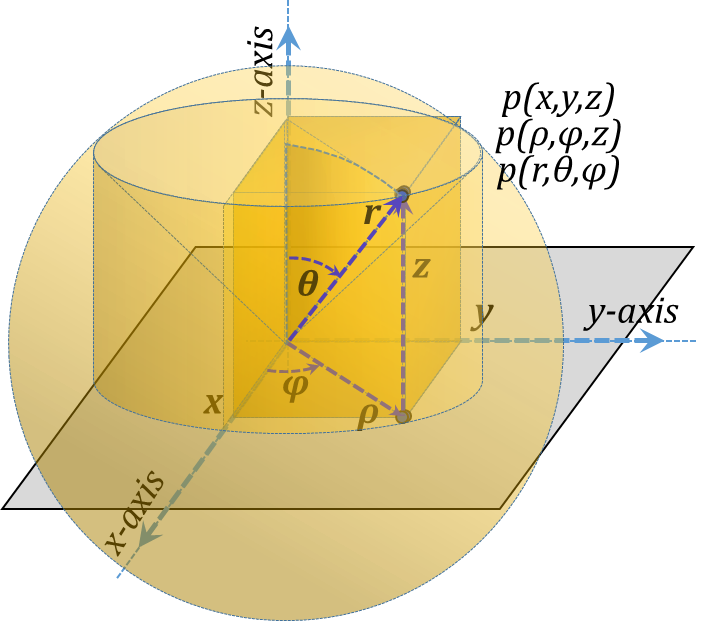Transition to Electrostatics - Electromagnetic Fields and Waves
Chapter Outcomes
 The Coordinate Systems
The Coordinate Systems
- Express the location of a point in 3-D space using rectangular (Cartesian), cylindrical and spherical coordinate systems.
- Express vector quantities in 3-D space using rectangular, cylindrical and spherical coordinate systems.
- Distinguish between a position vector and a general position independent vector.
- Explain the property of "location dependence/independence" of unit vector direction and magnitude in each of the rectangular, cylindrical and spherical coordinate systems.
- Describe differential line, area and volume elements in each of the three coordinate systems.
- Convert between point location representations in each of the coordinate systems.
- Convert between vector representations in each of the coordinate systems while taking into account the property of position dependence in each of the corresponding coordinate systems.
- Apply linear algebra operations between vectors including addition, subtraction and scaling.
- Apply the projection operation using the dot product (inner product) between two vectors and describe cases for which it is used.
- Apply the vector product between two vectors and describe cases for which it is used.
- Describe the spatial distribution/densities of scalar quantities in 3-D space including line, area and volume densities.
- Describe the spatial distribution/densities of vector quantities known as "vector field" 3-D space including line, area and volume densities.
- Calculate integrals of scalar quantities in 3-D space (functions in 3 variables).
- Calculate integrals of vector quantities in 3-D space (3 functions in 3 variables).
- Calculate integrals of both scalar and vector quantities over lines and surfaces.
Complete Chapter
Chapter Overview
In this chapter:
Introduction
Why study EM
RLCG, Models and Parasitics
Addendum I
Review of coordinate systems
Cartesian, Cylindrical, and Spherical
Differential elements in coordinate systems
Length, area, and volume increments
Unit vectors in different coordinate systems
Relationships between coordinate systems
Addendum II
Review of vector Calculus
Vector Definition and Examples
Vector Representations in Coordinate Systems
Vector Operations
Addendum III
Spatial Distributions and DensitiesStatic Quantities
Static Distributions and Densities
Dynamic Distributions and Densities
Concentrations, Line, Area, and Volume Distributions
Conversions between density expressions
Addendum IV
Line, Surface, and Volume Integrations
Integrating vector quantities
Integrating scalar quantities